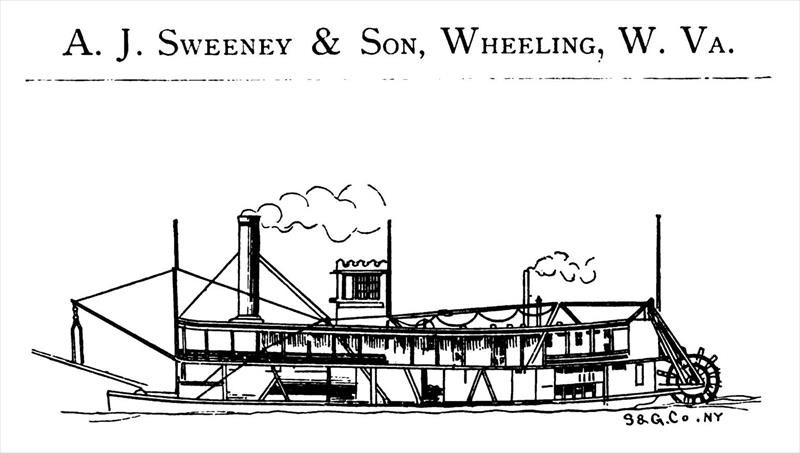The company's 1890 advertisement described the business as Builders of steamboats, hulls either of wood or composite construction. Complete plants for blast furnaces, sheet, bar and nail plate rolling mills, cut and wire nail factories with complete equipment. Complete machinery for the manufacture of plate glass. Iron house fronts and architectural iron work. Special machinery designed to specification. Castings of all kinds. Boilers to fill U. S. Government requirements. Sheet iron work.
Sweeney built the famous steamboat Bertrand which hit a snag on its maiden voyage and sank in the Missouri River April 1, 1865, with a full cargo of tools, hardware, clothing, canned food, and other household goods. The wreck was preserved in mud that reached 30 feet deep when the river changed course. The cargo of 500,000 items was recovered in 1969, and over half are displayed in the Steamboat Bertrand Museum in Iowa, as the largest single collection of Civil War period artifacts in the country.

1890 advertisement
Information Sources
- Seeger and Guernsey's Cyclopaedia of the Manufactures and Products of the U.S., 1890, Section II, Pg. 61
- Wikipedia - Bertrand (steamboat)
- Steamboat Bertrand Museum
- The Bertrand – Nebraska on the Frontier of Shipwreck Archaeology has photographs and a description of the boat's excavation.
- Ohio County Public Library - A. J. Sweeney & Son, Boatbuilders
Among the diversified work of Wheeling brains and Wheeling muscle, there is none more important than that represented by the firm of A. J. Sweeney & Son. In another place in this issue is a striking scene on the river front — two steamboats in process of construction. This picture is engraved from a photograph taken while the Messrs. Sweeney were working on a large cotton packet for the southern waters and a steamer for the Ohio trade.The Sweeney family has been identified with Wheeling industries for over half a century. In 1830 Thomas Sweeney came to Wheeling from Pittsburgh, and purchased the shops and property of the North Wheeling Manufacturing Company. With his brothers and sons he ran those works until about 1874, when he retired from active business. His son, A. J. Sweeney, and the latter's son, John M. Sweeney, assumed the business and conducted it until 1881, at the old place, and since, to date, at the works in the Sixth Ward purchased by them.The business at the old place was building engines, mill machinery and general castings, the firm being, until 1833, J. & C. Sweeney, which was dissolved by the death at that time of C. Sweeney. Then, until 1837, J. Sweeney carried on the works, then the firm of Sweeney, Matthews & Gray was formed, continuing until 1839, when it became Sweeney & Matthews, and was so until 1852. Then J. Sweeney and his son, Capt. J. C. Sweeney, continued as J. Sweeney & Co.In 1858 the machine shop of John Moore & Co. formed with the foundry firm a consolidation and the business was continued until 1874 under the style of Sweeneys & Co. The firm of John Moore & Co. consisted of John Moore, for many years superintendent of the city water works, and A. J. Sweeney. The death of Mr. Moore in 1858 dissolved that firm and a new partnership was formed by T. Sweeney and his sons A. J. and T. C. This firm built steamboats, rolling mills, boilers, and all kinds of general machinery and castings.The present firm of A. J. Sweeney & Son continued at the old place from 1875 until 1881, when the principal shop, with all its valuable machinery and patterns was destroyed by fire. The firm had purchased a large works, situated on Twenty-seventh street and extending from Chapline to Eoff streets in the Sixth ward.This works was built in 1852 by the firm of Hamilton & Clark, and was conducted by John Hamilton and various partners until 1872, when Mr. Hamilton's death occurred. Messrs. A. J. Sweeney & Son have purchased additional property adjoining the works and have added many thousand dollars worth of patterns and tools.They build steamboats, and contract to deliver them with steam up and complete in outfit. Their boats are unexcelled in speed, beauty and economy. They also build engines and boilers, and most of the large engines and rolling mills in this vicinity have been built by them or the firm which they succeed. They make a specialty of nail machines, and are now executing the largest order ever made at one time for such work. All of their work is done in the best style both as so workmanship and material. Their business amounts to between $150,000 and $200,000 per annum.